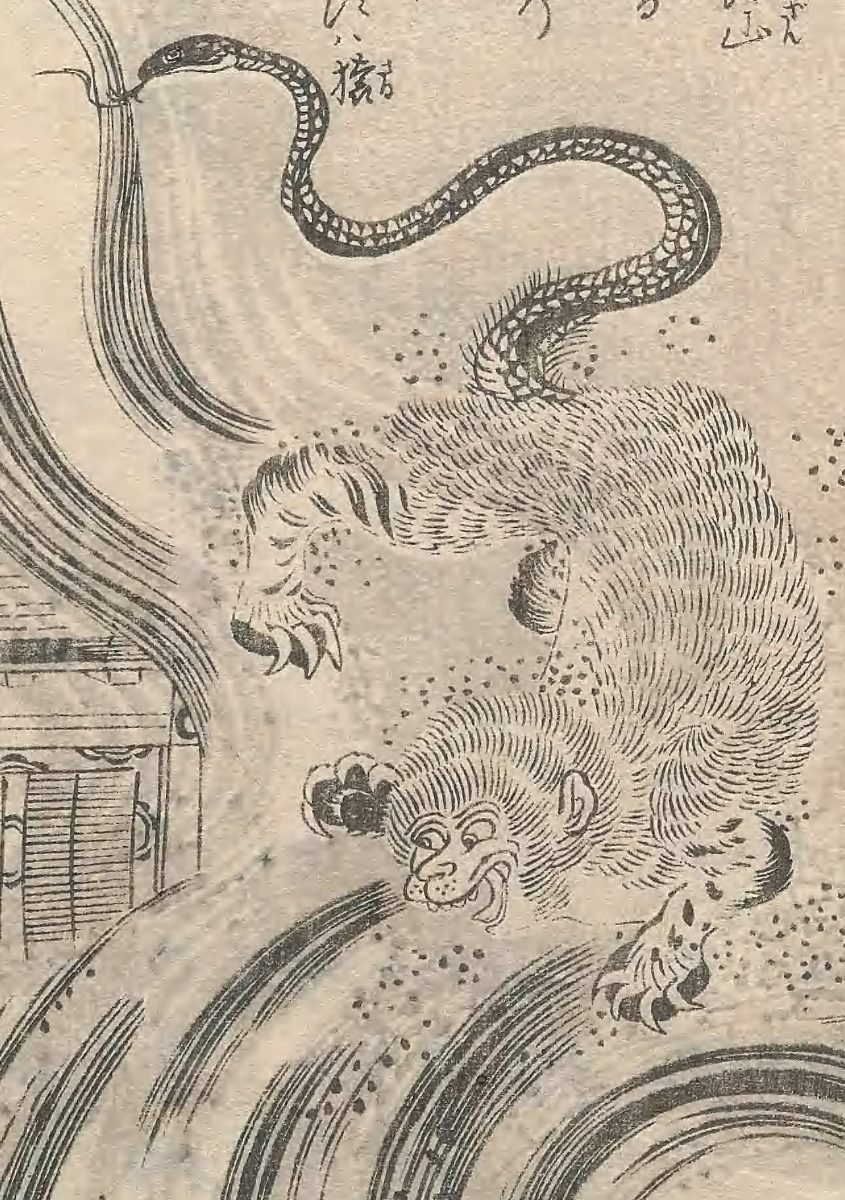In the Tale of Heike, it is described as a Japanese Chimera having the head of a monkey, the limbs of a tiger, the body of a Japanese raccoon dog, and the front half of a snake for a tail. In other writings nothing is stated about its torso, so it is sometimes depicted to have the torso of a tiger. The Genpei Jōsuiki describes it as having the back of a tiger, the limbs of a tanuki, the tail of a fox, the head of a cat, and the torso of a chicken. It is said to make terribly eerie bird cry “hyoo hyoo” noises that resemble that of the scaly thrush. The nue is also said to have the ability of shape-shifting, often into the form of a black cloud that can fly. The yokai is also thought to be nocturnal as most of its sightings happen at night. The nue is thought to have started appearing in the late Heian period. For a more precise dating, different sources claim different periods, like the Emperor Nijō period, the Emperor Konoe period, the Emperor Go-Shirakawa period, or the Emperor Toba period. The visual appearance may be a combination of the animals in the Sexagenary cycle, with a northeast Tiger, a southeast Snake, a southwest Monkey, and a northwest Qian (Dog and Wild Boar).
| Alias Nue (鵺) |
| Real Names/Alt Names ○ |
| Characteristics Yōkai, Medieval Age, Japanese |
| Creators/Key Contributors Toriyama Sekien, Tsukioka Yoshitoshi, Utagawa Kuniyoshi |
| First Appearance Japanese folklore |
| First Publisher ○ |
| Appearance List Heike Monogatari (c. 13th century; written form c. 1330), Gempei Seisuiki (c. 14th century), Taiheiki (mid-14th century), Otogi Zōshi: Yorimasa and the Nue (Muromachi period, 14th–16th centuries), Nue (Noh, c. 15th century), Nue Monogatari (Kabuki, Edo period, 18th–19th centuries), Hyakki Yagyō Emaki (16th century), Konjaku Gazu Zoku Hyakki (1779, Vol. 3) by Toriyama Sekien, Settsu Meisho Zue (1796–1798) by Akisato Ritō with illustrations by Takehara Shunchōsai, One Hundred Aspects of the Moon: The Nue (1887) by Tsukioka Yoshitoshi |
| Sample Read Konjaku Gazu Zoku Hyakki Vol. 3 “Dawn” (1779) [Smithsonian] |
| Description In the Tale of Heike, it is described as a Japanese Chimera having the head of a monkey, the limbs of a tiger, the body of a Japanese raccoon dog, and the front half of a snake for a tail. In other writings nothing is stated about its torso, so it is sometimes depicted to have the torso of a tiger. The Genpei Jōsuiki describes it as having the back of a tiger, the limbs of a tanuki, the tail of a fox, the head of a cat, and the torso of a chicken. It is said to make terribly eerie bird cry “hyoo hyoo” noises that resemble that of the scaly thrush. The nue is also said to have the ability of shape-shifting, often into the form of a black cloud that can fly. The yokai is also thought to be nocturnal as most of its sightings happen at night. The nue is thought to have started appearing in the late Heian period. For a more precise dating, different sources claim different periods, like the Emperor Nijō period, the Emperor Konoe period, the Emperor Go-Shirakawa period, or the Emperor Toba period. The visual appearance may be a combination of the animals in the Sexagenary cycle, with a northeast Tiger, a southeast Snake, a southwest Monkey, and a northwest Qian (Dog and Wild Boar). |
| Source Nue – Wikipedia |



